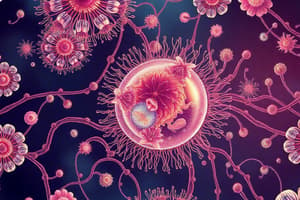Podcast
Questions and Answers
What is the primary function of the nucleus in a cell?
What is the primary function of the nucleus in a cell?
- To transport materials throughout the cell
- To store water and nutrients
- To produce energy through cellular respiration
- To control cellular processes and contain DNA (correct)
Which type of cells lack a nucleus?
Which type of cells lack a nucleus?
- Eukaryotic cells
- Prokaryotic cells (correct)
- Animal cells
- Plant cells
What are ribosomes primarily responsible for?
What are ribosomes primarily responsible for?
- Storing waste products
- Synthesizing proteins (correct)
- Modifying lipids
- Producing energy
What is the role of mitochondria in a cell?
What is the role of mitochondria in a cell?
Which structure within the nucleus is responsible for ribosome production?
Which structure within the nucleus is responsible for ribosome production?
What distinguishes rough ER from smooth ER?
What distinguishes rough ER from smooth ER?
What is the function of lysosomes in a cell?
What is the function of lysosomes in a cell?
Which structure is responsible for the wave-like movements in cells lining the respiratory tract?
Which structure is responsible for the wave-like movements in cells lining the respiratory tract?
What components do all cells have in common?
What components do all cells have in common?
Which organelle modifies and packages proteins for the cell?
Which organelle modifies and packages proteins for the cell?
Flashcards
What is a cell?
What is a cell?
The smallest living unit of an organism.
What is the cell membrane?
What is the cell membrane?
The outer boundary of a cell that separates the cell's contents from its external environment.
What is cytoplasm?
What is cytoplasm?
The gel-like substance within a cell, containing various structures and molecules.
What is DNA?
What is DNA?
Signup and view all the flashcards
What are eukaryotic cells?
What are eukaryotic cells?
Signup and view all the flashcards
What are prokaryotic cells?
What are prokaryotic cells?
Signup and view all the flashcards
What are organelles?
What are organelles?
Signup and view all the flashcards
What is the nucleus?
What is the nucleus?
Signup and view all the flashcards
What are ribosomes?
What are ribosomes?
Signup and view all the flashcards
What is the endoplasmic reticulum (ER)?
What is the endoplasmic reticulum (ER)?
Signup and view all the flashcards
Study Notes
What are Cells?
- Cells are the smallest living units of an organism
- All cells share three common features: a cell membrane, cytoplasm, and DNA
Cell Membrane
- Separates the cell's interior from the external environment
Cytoplasm
- Gelatinous fluid within the cell
DNA
- The cell's genetic material
Types of Cells
Eukaryotic Cells
- More complex than prokaryotic cells
- Contain organelles, including the nucleus and other specialized structures
- Found in plants and animals
Prokaryotic Cells
- Lack a nucleus or membrane-bound organelles
- Genetic material is not enclosed within a nucleus
- Always single-celled organisms (unicellular), like bacteria
What are Organelles?
- “Small organs”
- Specialized parts of the cell with specific functions
Nucleus
- Control center of the cell
- Contains DNA
- Dictates cellular processes and function
Chromatin
- DNA in its interlinked and dispersed form within the nuclear membrane
- Condenses into chromosomes when the cell is about to divide
Nucleolus
- Structure within the nucleus responsible for ribosome production
Ribosomes
- Synthesize proteins
- Move freely within the cytoplasm or attach to the endoplasmic reticulum (ER)
Endoplasmic Reticulum (ER)
- Network of membranes that transport materials like proteins (synthesized by ribosomes)
- Two types:
- Rough (granular) ER - ribosomes attached
- Smooth (agranular) ER - no ribosomes
Golgi Apparatus
- Also called Golgi body
- Receives proteins and other materials from the ER
- Modifies proteins
- Packages them into usable forms for the cell
- Adds lipids or carbohydrates to proteins
Vacuoles
- Sac-like structures for storing various materials
- In plant cells, the central vacuole stores water
Lysosomes
- Waste disposal centers
- Contain enzymes to break down used or damaged parts of the cell
Mitochondria
- Powerhouses of both plant and animal cells
- Produce ATP molecules through cellular respiration, which provides energy for cellular processes
- Cells with higher energy requirements have more mitochondria
Cytoskeleton
- Supports and maintains the shape of the cell
- Contains:
- Microfilaments: thin protein filaments
- Microtubules: hollow tubes
Chloroplasts
- Found in plant cells
- Site of photosynthesis
- Green due to the pigment chlorophyll
Cell Wall
- Present in plant cells outside the cell membrane
- Provides shape, support, and protection
Cilia
- Tiny hair-like projections
- Found in cells lining the respiratory tract
- Wave-like movements help capture inhaled particles and expel them through coughing
Flagella
- Tail-like structures
- Found in some bacteria
- Allow the cell to move or propel itself forward
- The only human cell with a flagellum is the sperm
Summary
- Eukaryotic cells (plant and animal cells) have a nucleus and membrane-bound organelles
- Prokaryotic cells (unicellular organisms) lack these features
- All cells have a cell membrane, cytoplasm, and genetic material
- Only plant cells have chloroplasts, but both plant and animal cells have mitochondria
Studying That Suits You
Use AI to generate personalized quizzes and flashcards to suit your learning preferences.




